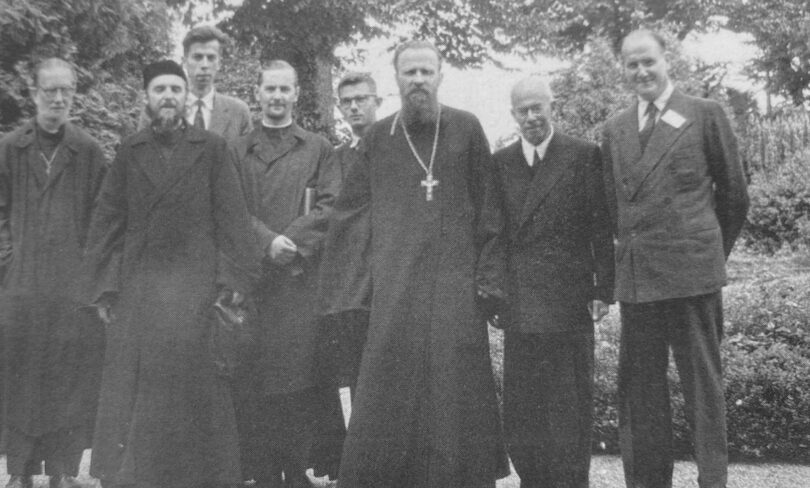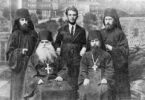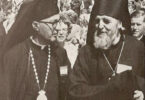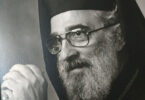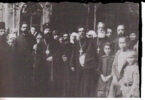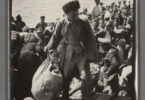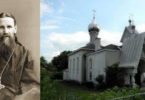Introduction
The 1948 publication by St. Job of Pochaev Press of Fr. Michael Polsky’s The Canonical Situation of the Higher Church Authority in the USSR and Abroad brought about a productive discussion. [1]All the written records of this discussion are reproduced on this site, in the Church Law section. Priest Alexander Schmemann outlined his thoughts in response to the chapter of this book on the “paths [of the Church] abroad” in his work “The Church and Church Structure. Regarding Archpriest Polsky’s Book The Canonical Position of the Supreme Church Authority in the USSR and Outside Russia”, which came out the following year. The present piece was written as a response to this work by Evkustodion Ivanovich Makharoblidze. It is impossible to study the first decade of ROCOR history without grasping the significance of this person. “Kustia,” as Metropolitan Antonii Khrapovitskii affectionately called him, came from a clergy family. His father was a military chaplain. Makharoblidze graduated from Tbilisi (Tiflis) Seminary and the Faculties of Law and Oriental Languages of St. Petersburg University. From 1911 to 1919, he was the office manager of Fr. Georgii Shaveʹskii, the last protopresbyter of the Russian Army and Navy. Judging by the fact that, in his memoirs V shkole i na sluzhbe [At School and on Duty][2]Moscow/Brussels, 2016, Fr. Georgii recalls Makharoblidze in neutral to positive tones,[3]p. 681 they must have had normal working relations. By virtue of his position under Fr. Giorgii, Makharoblidze joined the Supreme Church Administration in the South of Russia that Shavelʹskii organized in 1919 under Gen. Denikin in Novocherkassk. From this, it is clear why Makharoblidze became the office manager of the Supreme Church Administration Abroad in Constantinople and then in Belgrade. He was editor of Tserkovnye vedomosti [Church Bulletin], the bi-weekly press organ of the Synod of the Russian Orthodox Church Outside of Russia, from 1924 to 1930. While working as the secretary of the ROCOR chancellery in Serbia, Makharoblidze was part of Metropolitan Antonii Khrapovitskii’s inner circle. For instance, the latter wrote in a 1931 letter to Archbishop Gavriil Chepur: “At the insistence of Kustia, I dispatched a rejoinder to [Ecumenical] Patriarch Photios.”[4]Undated letter. Pisʹma Blazhenneishego Mitropolita Antoniia (Khrapovitskogo) [Letters of His Beatitude Metropolitan Antonii Khrapovitskii]. Jordanville. 1988. p. 217.
Makharoblidze pursued the line of ROCOR autocephaly, up to the point of breaking with Patriarch Tikhon. In his report at the Council of Bishops in 1922, he stated about the May 5, 1922, resolution by Patriarch Tikhon, the Holy Synod, and the Supreme Church Council to shut down the Supreme Church Administration Abroad: “The accusation by His Holiness the Patriarch that the Higher Church Administration has descended into politics is factually incorrect. There has not been a single official act of a political nature on the part of the Supreme Church Administration [Abroad]. And the messages that have incriminated him [about bringing back the Romanov dynasty in Russia, and about the Genoa conference on supporting the armed struggle against the Bolsheviks – A.P.] were nearly unanimous resolutions of the refugee church”. [5]A. Kostriukov. Russkaia Zarubezhnaia Tserkovʹ v pervoi polovine 1920-kh godov [The Russian Church Abroad in the Early 1920s]. Moscow: Saint Tikhon’s University Press, 2007, p. 100; cf. ibid., … Continue reading
Makharoblidze viewed the sociopolitical transformations taking place in Russia in the spirit of conspiracy theory: “One and all [in Soviet Russia] sincerely hate the apostate Jews, who are the principal authors of Russian misery.”[6]“Russia and Her Church”. Christian East, Dec. 1926: 177..
In 1931, Makharoblidze was dismissed from the Synod chancellery on charges of embezzlement. After the German occupation of Yugoslavia, he received permission from the Commander of the German troops in Serbia to continue publishing his magazine Tserkovnoe obozrenie [Church Review]. The line he pursued in it was in the spirit of Nazi propaganda.[7]Cf.: Mikhail Shkarovskii, The Russian Orthodox Church Outside of Russia and the Holocaust. After the end of World War II, Makharoblidze was secretary to the Diocesan Council of the ROCOR Diocese of Germany, editor of the journal Tserkovnye vedomosti [Church Bulletin] of the Orthodox Church in Germany, and active in ecumenical dialogue. He passed away in 1960.
This response to Fr. Alexander Schmemann is part of a series of articles Makharoblidze sent to Fr. George Grabbe while the ROCR Synod was in Munich. The original is kept in the Archive of the Synod of Bishops in New York City, File 38/58 (Western European Diocese). Copies were kindly provided to me by Archpriest Andrei Papkov. I am grateful to Larissa Wir and Archpriest Nikolai Artemoff for their help in transcribing the handwritten originals.
Protodeacon Andrei Psarev, May 19, 2022
I hope that this brochure, whose author is successfully distributing it free of charge all over Western Europe with a particular goal in mind, will be subjected to academic analysis by any of the learned canonists who will give it an unbiased scholarly review. If no one will do this, then I, a “poorly trained canonist,” will allow myself to take up this work. Unfortunately, at present I do not have on hand the necessary resources and materials, so for now I will share some brief thoughts with my readers that came to me as I read the brochure by Priest Schmemann.
Fr. Schmemann is surprised that Archpriest M. Polsky proclaims specifically Apostolic Canon 34 rather than any other canon as a “basis criterion.” I believe that this question is very clear, since Fr. Polsky is looking at the canonical situation of the Supreme Church Authority in the USSR and abroad, while Apostolic Canon 34 speaks specifically of this authority exercised by the Council of Bishops and the first among them.
Priest Schmemann writes, “The Church’s polemical émigré literature has curious cases of two diametrically opposite viewpoints that were being proven and justified by the same canons.”
Yes, unfortunately such cases did occur. It was none other than Metropolitan Evlogii who used the same canons in 1923, 1924, and 1925 to deny the rights of the Ecumenical Patriarch to interfere in matters of other Churches and defended his rights and those of the Synod of Bishops of the Russian Orthodox Church Abroad from him, while between 1927 and 1930, he was doing the opposite by justifying the rights of the Ecumenical Patriarch. We marveled at this at the time. This sin was committed by the Ecumenical (Constantinople) Patriarch himself. Between 1923 and 1925, he acknowledged that Metropolitan Evlogii was “an uncanonical ruling bishop of Russian churches in Western Europe,” but in 1926 and 1927, he already recognized him as canonical.
Priest Schmemann attests that: “Usually, ‘zealots of canonical formalism’ who are poorly informed in theology and church history see in a canon only its letter and regard as ‘heresy’ any attempt to discern meaning behind the letter.”
Apparently only Fr. Schmemann has a correct and good understanding of the canon and knowledge of church history, while those 34 Russian bishops who were involved in organizing the Supreme Church Authority Abroad, including major learned theologians and canonists, rectors, and professors of theological academies, known for their scholarly formation and academic work throughout the entire Christian world, knew nothing. Only now we are learning everything about canonical truth from the mouth of Fr. Schmemann, who had gone through the course of the so-called “Theological Institute,” at a time when the instructors invited there had mostly “not received higher theological education or whose Orthodoxy was highly doubtful for the Synod and the Council.” (Message of the Synod of Bishops of August 18/31, 1927).
Yes, but there are canons that can be characterized as being “juridical documents” or “administrative rules.” Some examples are canons about the books of Holy Scripture, sacraments, fasts, penances, the selection of bishops, trials of them and of clergy, the qualities of candidates to the priesthood, etc. An entire treatise could be written on this topic.
Speaking of church structure and the application of one canon or another in appropriate cases, Priest Schmemann forgets that each local church is guided in its administration by its own conciliar rulings in addition to the canons. The canons say nothing about patriarchal administration, the Holy Synod, or the Supreme Church Authority. And yet all of this exists and determination about this is a kind of canon for a given local church. Resolution 362 by the Supreme Church Authority of November 20, 1920, belongs to this category. It is telling that this ruling was recognized in 1922 as being applicable to the diaspora. The Dioceses of Finland, Riga, Lithuania, China, Japan, Harbin, and America, and the Jerusalem and Urmia Missions recognized this, and only Metropolitan Evlogii and his diocese started denying it after 1926.
As affirmation of his thoughts regarding the unity of the Church, Priest Schmemann quotes V. Troitskii, subsequently Archbishop Hilarion, the Confessor of Solovki, from his 1912 work Ocherki iz istorii dogmata o Tserkvi [Essays From the History of the Teaching on the Church].
But I see that Fr. Schmemann does not know that this archbishop, a champion of Orthodoxy, upbraided Patriarch Tikhon for shutting down, at the demand of the Soviet authorities, the Supreme Church Administration Abroad and took part in compiling a whole series of church literature in Soviet Russia, including “Regarding the Relationship of the Church to the Soviet Regime” and “An Analysis of the Actions of all Groups After July 16/29, 1927, with an Indication of How To Find A Way Out of The Existing Situation. Two Discussions By ‘Two Friends’ in a Historically-Canonical Exposition,” which defends the Russian Church Abroad and justifies its existence.
Everything that Fr. Schmemann writes about church unity, citing various better- and lesser-known professors, is correct. It should be just so when the Church is “at peace.” This expresses the Church’s ideal. But it has nothing to do with church administration. Churches are administered in different ways. Local ones are administered by patriarchs, others by synods, and still others by metropolitans, but there is no general administrative consensus across all Local Churches in Orthodoxy.
The Pope brings together all Catholics administratively, wherever they may live, as well as Greek Catholics and those of the Eastern Rite. This means that he has the true Church, according to Fr. Schmemann’s logic, since there is full union and unity here, dogmatically and administratively.
There was a time when the Churches were divided by differences in the days Pascha, Christmas, and Christ’s Baptism were celebrated, and even this didn’t disrupt their unity. There was a time when the entire episcopate of a Local Church would break away, but this didn’t destroy the Churches’ unity.
“The territoriality of the Church,” writes Fr. Schmemann, “means that only one Church can exist in one territory – in other words, a single church organization, expressed in the unity of its leadership.”
That is perfectly true. But the history of the Church knows exceptional cases when bishops of another church ruled from the territory of a foreign bishop over their ecclesiastical region or over a flock that accompanied its bishop. In such exclusive cases, the heads of Churches can, “in a spirit of brotherly love,” allow this as applied to canons 37 and 39 of the Sixth Ecumenical Council and canon 1 of the Constantinople Council at the Church of St. Sophia.
And so, in 1926 the Patriarchate of Constantinople allowed Russian bishops to be in Constantinople, and, later, the Churches of Serbia and Bulgaria allowed them to be in their territory. Western Europe did not have a local church, but it did have Russian churches subject to the Metropolitan of St. Petersburg, who was given a special vicar in 1912 or 1913 who had to live outside Russia for this. These Russian churches abroad along with their dioceses thus comprise the part of the Russian Orthodox Church that is outside Russia.
It is strange that the Patriarch of Constantinople, who bears the Ecumenical title merely nominally, is able to have under his rule churches with insignificant parishes outside their ecclesiastical territories, administering them through exarchates, while the Russian Church cannot do this. The canons do not give any such rights to the Ecumenical Patriarch, and in Western Europe, the Russian diocesan administration was organized earlier than the Constantinople Exarchate.
The unification of the entire Orthodox Church under one earthly headship, which Priest Schmemann dreams about, could only occur through God’s intentional will and through God singling out a holy man from among the bishops for this purpose. In order to affirm his own authority, the Pope had to conjure up the dogma of his infallibility in dogmatic issues. But this helped them little (they had so many splits). For it is one thing to be infallible when God grants this, and another when one calls himself that. And I would think that when Christ was praying in his High Priestly Prayer, “That they all may be one; as thou, Father, art in me, and I in thee, that they also may be one in us: that the world may believe that thou hast sent me” (Jn. 17:21), or when He said in the parable, “And there will be one flock and one shepherd” (Jn. 10:16), He least of all had in mind the headship of His Church by a single bishop of Rome or Constantinople – the New Rome. The one flock is all humanity, and the one shepherd is Christ God.
“The Church is always ultimately ‘in this world,’” continues Fr. Schmemann, “and equally ‘not of this world,’ and Her essence, Her life, does not depend upon the forms of the world.”
Yes, the Church’s essence does not depend upon the forms of this world, but Her life does to a great extent, and we see this in the entire history of God’s Church. In fact, there is no need even to journey deep into history, for we can see this in the life of the Churches in Eastern Europe and particularly in the Soviet Union. Over there, this dependence has caused the entire life of the Church to be completely knocked out of its ecclesiastical orbit. A Church leadership has taken shape in the form of a Soviet, rather than an ecclesiastical, hierarchy, conducting church life along a course that is not ecclesiastical. It cannot appoint or transfer bishops and clergy without the consent and approval of “someone” who is not a church member. It cannot disclose the Church’s truth to its flock, teach it Gospel ideals freely and without control. It is even obliged to condemn the confessors of the faith and had to make significant corrections to orders of service as instructed by the authorities, and so on. And thus, from the opposite end, the true Church in the Soviet Union, in the person of its hierarchy, clergy, and laity who had not submitted to the Soviet hierarchy, having the Church’s essence, went off to conduct its church life in the catacombs. And several hierarchs turned out to be in one spot, ruling and guiding their flocks, dispersed in various places in the Soviet Union. This is how much the life of the Church depends today upon the forms of “this world.” Apparently, Fr. Schmemann does not see what is taking place in this world. His horizon is limited to rue Daru 12 and rue de Crimée 93. For now, church life there does not depend upon the forms of this world, and may God grant that this will continue.
References
| ↵1 | All the written records of this discussion are reproduced on this site, in the Church Law section. |
|---|---|
| ↵2 | Moscow/Brussels, 2016 |
| ↵3 | p. 681 |
| ↵4 | Undated letter. Pisʹma Blazhenneishego Mitropolita Antoniia (Khrapovitskogo) [Letters of His Beatitude Metropolitan Antonii Khrapovitskii]. Jordanville. 1988. p. 217 |
| ↵5 | A. Kostriukov. Russkaia Zarubezhnaia Tserkovʹ v pervoi polovine 1920-kh godov [The Russian Church Abroad in the Early 1920s]. Moscow: Saint Tikhon’s University Press, 2007, p. 100; cf. ibid., p. 218. |
| ↵6 | “Russia and Her Church”. Christian East, Dec. 1926: 177. |
| ↵7 | Cf.: Mikhail Shkarovskii, The Russian Orthodox Church Outside of Russia and the Holocaust. |

